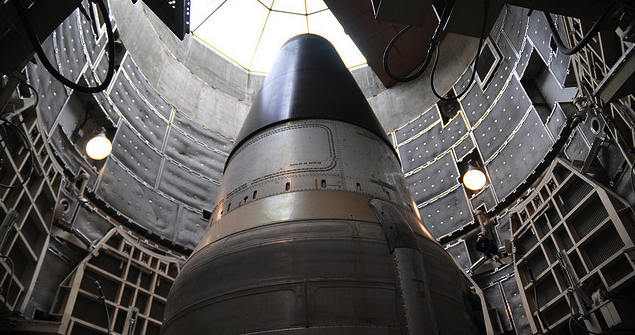Who Will Bell the Nuclear Cat?

The global nuclear disarmament and non-proliferation agenda has stalled. Yet disarmament is the only way to fully eliminate nuclear weapons risk.
Five years ago hopes were high that the world was at last headed towards nuclear disarmament. In April 2009 the (then) exciting new US President Barack Obama gave an inspiring speech in Prague wherein he outlined his dream of a world freed of the existence and threat of nuclear weapons. The United States and Russia negotiated a new strategic arms reduction treaty (New START) that cuts their deployed strategic nuclear warheads by one-third to 1,550 each. The inaugural Nuclear Security Summit in Washington attracted broad international buy-in to an ambitious new agenda. In contrast to the scandalous failure of its 2005 predecessor, the 2010 Non-Proliferation Treaty (NPT) Review Conference was a modest success.
By the end of 2012, as reported in our inaugural report, much of this sense of optimism had evaporated. By the end of 2014, as our follow-up report Nuclear Weapons: The State of Play 2015 documents, pessimism had returned.
North Korea conducted its third nuclear test in 2013 and the Comprehensive Nuclear Test Ban Treaty (CTBT) is yet to enter into force. We are no closer to resolving the challenge posed by North Korea and a comprehensive agreement on Iran eluded negotiators by the extended deadline last November. Talks on an NPT-mandated nuclear-weapon-free zone in the highly volatile Middle East have stalled.
New START was signed and ratified, but it left stockpiles intact and disagreements about missile defence and conventional-arms imbalances unresolved. Nuclear weapons numbers have decreased in the US, Russia, UK and France, but are increasing in Asia (India, Pakistan, China and North Korea); and fissile material production to make still more warheads is not yet banned.
Cyber-threats to nuclear weapons systems have intensified, outer space remains at risk of nuclearisation and the upsurge of geopolitical tensions over the crisis in Ukraine has produced flawed conclusions about the folly of giving up nuclear weapons, on the one hand, and open reminders about Russia’s substantial nuclear arsenal, on the other.
The peoples of the world recognise the risks and dangers of nuclear arsenals. Curiously, however, their concerns and fears find little reflection in media coverage or governments’ policy priorities. In a Pew Research Center survey, nuclear weapons were chosen as the top threat in 10 of the 44 countries polled (including nuclear-armed states Russia and Pakistan), and as the second gravest threat in another 16 (including China). They were rated the top threat by 20% of the people in the Middle East, 19% in Europe, 21% in Asia, 26% in Latin America, 22% in Africa and 23% in the US.
Latin America’s anti-nuclear commitment was reinforced by the regional nuclear-weapon-free zone in 1967 under the Treaty of Tlatelolco, which consolidates and deepens the NPT prohibitions on the bomb. Virtually the entire southern hemisphere has embraced additional comparable zones since in the South Pacific, Southeast Asia and Africa. Consequently looking out at the world from our vantage point, we see no security upsides by way of benefits from nuclear weapons, only risks.
Indeed it helps to conceptualise the nuclear weapons challenge in the language of risks. Originally many countries acquired the bomb in order to help manage national security risks. As the four famous strategic heavyweights of Henry Kissinger, Sam Nunn, William Perry and George Shultz – all card-carrying realists – argued in a series of five influential articles in The Wall Street Journal (2007–13), after the Cold War, the risks of nuclear proliferation and terrorism far outweigh their modest contributions to security.
Viewed through this lens, the nuclear risks agenda has four components.
Risk management. We must ensure that existing weapons stockpiles are not used; that all nuclear weapons and materials are secured against theft and leakage to rogue actors like terrorist groups; and that all nuclear reactors and plants have fail-safe safety measures in place with respect to designs, controls, disposal and accident response systems.
Risk reduction, for example by strengthening the stability-enhancing features of deterrence, such as robust command and control systems and deployment on submarines. Russia and the US could help by taking their 1,800 nuclear warheads off high-alert, ready to launch within minutes of threats being supposedly detected. Other countries could abandon their interest in things like tactical nuclear weapons that have to be deployed on the forward edges of potential battlefields and require some pre-delegation of authority to use to battlefield commanders. Because any use of nuclear weapons could be catastrophic for planet Earth, the decision to do so must be restricted to the highest political and military authorities.
Risk minimisation. There are no national security objectives that Russia and the US could not meet with a total arsenal of under 500 nuclear warheads each deployed in the air (a few), on land (some) and at sea (most). And if all the others froze their arsenals at current levels, this would give us a global stockpile of 2,000 bombs instead of the current total of nearly 16,400.
Ratifying and bringing into force the CTBT, concluding a new fissile material cutoff treaty, banning the nuclear weaponisation of outer space, respecting one another’s sensitivities on missile defence programs and conventional military imbalances, etc. would all contribute to minimising risks of reversals and setbacks.
None of these steps would jeopardise the national security of any of the nuclear-armed states; each would enhance regional and international security modestly; all in combination would greatly strengthen global security.
Risk elimination. Successive international commissions, from the Canberra Commission through the Tokyo Forum, Blix Commission and Evans–Kawaguchi Commission have emphatically reaffirmed three core propositions. As long as any state has nuclear weapons, others will want them. As long as they exist, they will be used again some day, by design, miscalculation, accident, rogue launch or system malfunction. Any such use anywhere could spell catastrophe for the planet.
The only guarantee of zero nuclear weapons risk, therefore, is to move to zero nuclear weapons possession by a carefully managed process.
Nuclear Weapons: The State of Play 2015, written by Gareth Evans, Tanya Ogilvie-White and Ramesh Thakur, can be downloaded for free here.
Ramesh Thakur is the Director of the Centre for Nuclear Non-Proliferation and Disarmament, the Australian National University. This article can be republished with attribution under a Creative Commons Licence.





